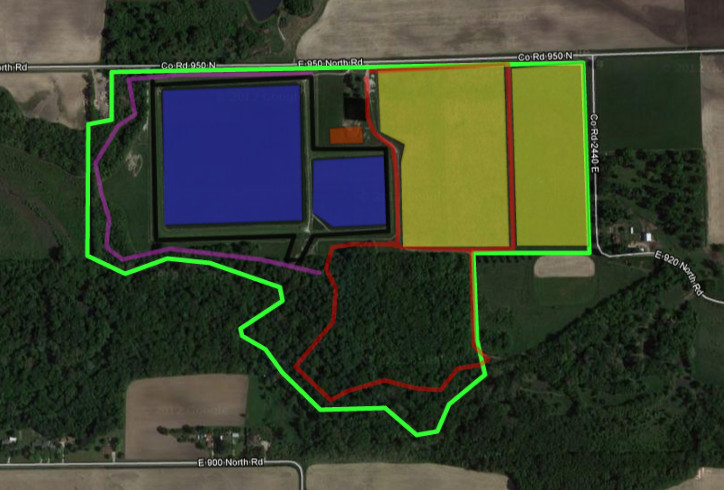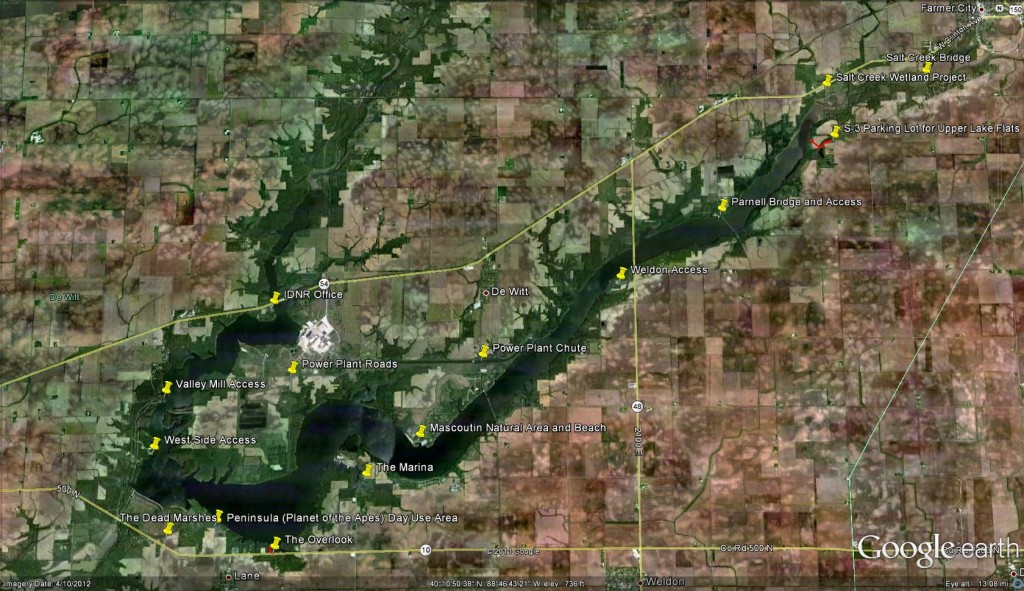Just east of the village of Milford, along the south side of County Road 950 N, this site is a lovely area full of habitat in the middle of the corn desert. There are two large water water treatment ponds, a trail through riparian, bottomland woods, a couple tallgrass prairie restoration plots, a smattering of old fields, and agricultural land.
Start by birding the ponds. Morning is better for this as the sun glare in the afternoons makes it difficult. There is no access within the fences of the ponds but a large mound of dirt is present at the northeast side of the ponds. This can be climbed and the ponds can be scoped from the top. Some of the better birds found on and around the ponds have been Common Loon, Black Scoter, Black Tern, Bonaparte’s Gull, Snow, Ross’s, Greater White-fronted, and Cackling geese, Merlin, and Peregrine Falcon. Most of the more common ducks find their way to the pond, and all of the states regular swallows are fairly common in May.
After your fill of the ponds, it is suggested that you walk the dirt road between the ponds and the tallgrass prairie restoration plots. This edge is good for various sparrows, American Tree Sparrows abound in the winter. At the right times of years, Sedge Wren, Dickcissel, and Bobolink are findable in the prairie. Once reaching the southeast fence corner of the ponds, turn west and bird the forest edge. The best birds along here in past years have been Olive-sided Flycatcher, Black-billed Cuckoo, and Cape May Warbler. The Cape May is one of 29 warbler species that have been found on the property. Most of these warblers are found in the next section of the property, however, the riparian bottomlands.
Following the south fence on foot to the west, there will eventually be a car-wide trail that runs into the woods to the south. This will pass by an unsanctioned campsite and go down a hill. This path that eventually curves east along the north bank of Sugar Creek is especially excellent during the migration months. Aside from the warblers, there has been a breeding pair of Pileated Woodpeckers in past years and Lincoln’s Sparrows are readily locatable in the fall. Winter months give way to Golden-crowned Kinglets, Red-breasted Nuthatches, Winter Wrens and Brown Creepers.
This trail will eventually pop out of the woods at an old field. Here, you will turn left and continue up a dirt road to the north between brushy field on your east and the forest on your west. It is along this stretch of trail where a female Spotted Towhee was found in October of 2010. This section is good for sparrows, especially Field Sparrow (on territory), Brown Thrashers and Common Yellowthroat.
This road will eventually butt into the south edge of the western prairie plot. Here, you can turn right and take your first left, walking between the two prairie plots. You’ll probably flush up a Ring-necked Pheasant or two. This trail will give you another opportunity to pick up some of the grassland birds. No Ammodramus has ever been found on the property but it is very plausible for a Grasshopper or Henslow’s to show up. After reaching the north edge of the prairie, you can turn west and walk between the prairie and the road until eventually getting back to the parking area by the dirt mound. The ponds are always worth another scoping.
One other area to bird on the property is the small patch of woods to the west of the ponds. You can drive west from the dirt mound area and you’ll have to look hard, but there is a sign for bike trails just west of where the north fence of the ponds ends. You can turn south into here and park. There is a small system of mountain bike trails in the woods west of the ponds. Much of the same species that are in the south woods are found here. However, one section has a damp, seep-like area that has been decent for American Woodcock in the past.
and interactive version of the below map can be found: http://goo.gl/maps/JJ5CM

